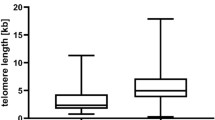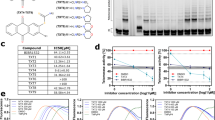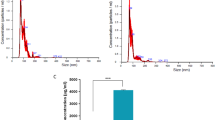Abstract
Telomeres and their maintenance by telomerase have been implicated to play an important role in carcinogenesis. As almost all malignant tumors express telomerase (in contrast to normal somatic cells), assessment of its activity has been proposed as a diagnostic and prognostic tool. To test the prognostic value of telomerase in pediatric soft tissue sarcoma (STS), we analyzed telomere length (by telomere restriction fragment analysis), telomerase activity (by modified telomerase repeat amplification protocol assay), and expression of human telomerase reverse transcriptase (hTERT) mRNA (by TaqMan technique) in cell lines of different types of STS from 12 children and adolescents. Telomere length (3.7–9.0 kb) showed a very heterogeneous pattern, independent of subtype of STS or the age of the patients, and it was not associated with expression of hTERT mRNA. In contrast, there was a trend of an association between hTERT and telomerase activity. The three tested cell lines of embryonal rhabdomyosarcomas demonstrated no or low (n = 2) telomerase activity, which was confirmed in two cases by a very low expression of hTERT mRNA. Thus, we suggest that the significant difference (p < 0.01) in the less aggressive clinical behavior of embryonal rhabdomyosarcomas in comparison to other subtypes may be due to differences in telomerase expression. Taken together, our cell line experiments imply that telomerase activity might be a biologic marker for stratification between STS with different clinical prognosis.
Similar content being viewed by others
Log in or create a free account to read this content
Gain free access to this article, as well as selected content from this journal and more on nature.com
or
Abbreviations
- TRF:
-
telomere restriction fragment
- TRAP:
-
telomerase repeat amplification protocol
- STS:
-
soft tissue sarcoma
- hTERT:
-
human telomerase reverse transcriptase
- RME:
-
embryonal rhabdomyosarcoma
- RMA:
-
alveolar rhabdomyosarcoma
- PNET:
-
peripheral neuroectodermal tumor
- RT:
-
rhabdoid tumor
REFERENCES
Campisi J, Kim SH, Lim CS, Rubio M 2001 Cellular senescence, cancer and aging: the telomere connection. Exp Gerontol 36: 1619–1637
Dhaene K, Van Marck E, Parwaresch R 2000 Telomeres, telomerase and cancer: an up-date. Virchows Arch 437: 1–16
Blackburn EH 1991 Structure and function of telomeres. Nature 350: 569–573
Wright WE, Shay JW 2000 Telomere dynamics in cancer progression and prevention: fundamental differences in human and mouse telomere biology. Nat Med 6: 849–851
Wenz C, Enenkel B, Amacker M, Kelleher C, Damm K, Lingner J 2001 Human telomerase contains two cooperating telomerase RNA molecules. EMBO J 20: 3526–3534
Morin GB 1989 The human telomere terminal transferase enzyme is a ribonucleoprotein that synthesizes TTAGGG repeats. Cell 59: 521–529
Hahn WC 2001 Telomerase and cancer: where and when?. Clin Cancer Res 7: 2953–2954
White LK, Wright WE, Shay JW 2001 Telomerase inhibitors. Trends Biotechnol 19: 114–120
Perry PJ, Arnold JR, Jenkins TC 2001 Telomerase inhibitors for the treatment of cancer: the current perspective. Expert Opin Investig Drugs 10: 2141–2156
Kim NW, Piatyszek MA, Prowse KR, Harley CB, West MD, Ho PL, Coviello GM, Wright WE, Weinrich SL, Shay JW 1994 Specific association of human telomerase activity with immortal cells and cancer. Science 266: 2011–2015
Hess JL, Highsmith WE 2002 Telomerase detection in body fluids. Clin Chem 48: 18–24
Nakamura TM, Morin GB, Chapman KB, Weinrich SL, Andrews WH, Lingner J, Harley CB, Cech TR 1997 Telomerase catalytic subunit homologs from fission yeast and human. Science 277: 955–959
Hisatomi H, Nagao K, Kanamaru T, Endo H, Tonimatsu M, Hikiji K 1999 Levels of telomerase catalytic subunit mRNA as a predictor of potential malignancy. Int J Oncol 14: 727–732
Yan P, Coindre JM, Benhattar J, Bosmann FT, Guillou L 1999 Telomerase activity and human telomerase reverse transcriptase mRNA expression in soft tissue tumors: correlation with grade, histology, and proliferative activity. Cancer Res 59: 3166–3170
Schneider-Stock R, Rys J, Jaeger V, Niezabitowski A, Kruczak A, Sokolowski A, Roessner A 1999 Prognostic significance of telomerase activity in soft tissue sarcomas. Int J Oncol 15: 775–780
Aogi K, Woodman A, Urquidi V, Mangham DC, Tarin D, Goodison S 2000 Telomerase activity in soft-tissue and bone sarcomas. Clin Cancer Res 6: 4776–4781
Yoo J, Robinson RA 2000 Expression of telomerase activity and telomerase RNA in human soft tissue sarcomas. Arch Pathol Lab Med 124: 393–397
Koscielniak E, Harms D, Henze G, Jurgens H, Gadner H, Herbst M, Klingebiel T, Schmidt BF, Morgan M, Knietig R, Treuner J 1999 Results of treatment for soft tissue sarcoma in childhood and adolescence: a final report of the German Cooperative Soft Tissue Sarcoma Study CWS-86. J Clin Oncol 17: 3706–3719
Harms D 1995 Soft tissue sarcomas in the Kiel Pediatric Tumor Registry. In: Harms D, Schmidt D (eds) Current Topics in Pathology. Springer-Verlag, Berlin, pp 31–45.
Scholl FA, Betts DR, Niggli FK, Schäfer BW 2000 Molecular features of a human rhabdomyosarcoma cell line with spontaneous metastatic progression. Br J Cancer 82: 1239–1245
Koscielniak E, Morgan M, Treuner J 2002 Soft tissue sarcoma in children: prognosis and management. Paediatr Drugs 4: 21–28
Verstegge I, Sévenet N, Lange J, Rousseau-Merck RM, Ambros P, Handgretinger R, Aurias A, Delattre O 1998 Truncating mutations of hSNF5/INI1 in aggressive paediatric cancer. Nature 394: 203–206
Kushner BH, LaQuaglia MP, Cheung NKV, Kramer K, Hamelin AC, Gerald WL, Ladanyi M 1999 Clinically critical impact of molecular genetic studies in pediatric solid tumors. Med Pediatr Oncol 33: 530–535
Gordon T, McManus Aidan, Anderson J, Min T, Swansbury J, Pritchard-Jones K, Shipley J 2001 Cytogenetic abnormalities in 42 rhabdomyosarcoma: a United Kingdom Cancer Cytogenetics Group Study. Med Pediatr Oncol 36: 259–267
Handgretinger R, Kimmig A, Koscielniak E, Schmidt D, Rudolph G, Wolburg H, Paulus W, Schilbach-Stueckle K, Ottenlinger C, Menrad A, Sproll M, Bruchelt G, Dopfer R, Treuner J, Niethammer D 1990 Establishment and characterization of a cell line (Wa-2) derived from an extrarenal rhabdoid tumor. Cancer Res 50: 2177–2182
Friedrich U, Griese E, Schwab M, Fritz P, Thon K, Klotz U 2000 Telomere length in different tissues of elderly patients. Mech Ageing Dev 119: 89–99
Friedrich U, Schwab M, Griese E, Fritz P, Klotz U 2001 Telomeres in neonates: new insights in fetal hematopoiesis. Pediatr Res 49: 252–256
Bièche I, Nogues C, Paradis V, Olivi M, Bedossa P, Lidereau R, Vidaud M 2000 Quantification of hTERT gene expression in sporadic breast tumors with a real-time reverse transcription-polymerase chain reaction assay. Clin Cancer Res 6: 452–459
Piatyszek MA, Kim NW, Weinrich SL, Hiyama K, Hiyama E, Wright WE, Shay JW 1995 Detection of telomerase activity in human cells and tumors by a telomeric repeat amplification protocol (TRAP). Methods Cell Sci 17: 1–15
Helmke L, Engler S, Mattke A, Henne-Bruns D 2001 Extrarenal malignant rhabdoid tumors in childhood. Med Pediatr Oncol 36: 317–319
Counter CM, Hirte HW, Bacchetti S, Harley CB 1994 Telomerase activity in human ovarian carcinoma. Proc Natl Acad Sci U S A 91: 2900–2904
Schneider-Stock R, Epplen C, Radig K, Oda Y, Dralle H, Hoang-Vu C, Epplen JT, Roessner A 1998 On telomere shortening in soft-tissue tumors. J Cancer Res Clin Oncol 124: 165–171
Bryan TM, Reddel RR 1997 Telomere dynamics and telomerase activity in in vitro immortalised human cells. Eur J Cancer 33: 767–773
Hoare SF, Bryce LA, Wisman GB, Burns S, Going JJ, van der Zee AG, Keith WN 2001 Lack of telomerase RNA gene hTERC expression in alternative lengthening of telomeres cells is associated with methylation of the hTERC promoter. Cancer Res 61: 27–32
Yan P, Benhattar J, Coindre JM, Guillou L 2002 Telomerase activity and hTERT mRNA expression can be heterogeneous and does not correlate with telomere length in soft tissue sarcomas. Int J Cancer 98: 851–856
Ulaner GA, Hu JF, Vu TH, Giudice LC, Hoffman AR 1998 Telomerase activity in human development is regulated by human telomerase reverse transcriptase (hTERT) transcription and by alternate splicing of hTERT transcripts. Cancer Res 58: 4168–4172
Kanamaru T, Tanaka KI, Kotani J, Ueno K, Yamamoto M, Idei Y, Hisatomi H, Takeyama Y 2002 Telomerase activity and hTERT mRNA in development and progression of adenoma to colorectal cancer. Int J Mol Med 10: 205–210
Sangiorgi L, Gobbi GA, Lucarelli E, Sartorio SM, Mordenti M, Ghedini I, Maini V, Scrimieri F, Reggiani M, Bertoja AZ, Benassi MS, Picci P 2001 Presence of telomerase activity in different musculoskeletal tumor histotypes and correlation with aggressiveness. Int J Cancer 95: 156–161
Bryan TM, Englezou A, Dalla-Pozza L, Dunham MA, Reddel R 1997 Evidence for an alternative mechanism for maintaining telomere length in human tumors and tumor-derived cell lines. Nat Med 3: 1271–1274
Henson JD, Neumann AA, Yeager TR, Reddel R 2002 Alternative lengthening of telomeres in mammalian cells. Oncogene 21: 598–610
Acknowledgements
The authors thank Mrs. D. Weller and Mrs. K. Simon-Klingenstein for the valuable technical assistance. The cell line MON was kindly provided by Dr. O. Delattre (Paris). We also thank Mrs. Bonilla Torres for secretarial help.
Author information
Authors and Affiliations
Corresponding author
Additional information
Supported by the Robert Bosch Foundation Stuttgart, Germany, and by Krebsforschung Schweiz (to B.W.S.).
Rights and permissions
About this article
Cite this article
Kleideiter, E., Schwab, M., Friedrich, U. et al. Telomerase Activity in Cell Lines of Pediatric Soft Tissue Sarcomas. Pediatr Res 54, 718–723 (2003). https://doi.org/10.1203/01.PDR.0000086901.29111.2A
Received:
Accepted:
Issue date:
DOI: https://doi.org/10.1203/01.PDR.0000086901.29111.2A
This article is cited by
-
Relative telomere length and oxidative stress in musculoskeletal tumors
Molecular Biology Reports (2019)
-
Distribution and prognostic significance of human telomerase reverse transcriptase (hTERT) expression in giant-cell tumor of bone
Modern Pathology (2008)
-
Telomeres and telomerase in paediatric patients with T-cell acute lymphoblastic leukaemia (T-ALL)
Leukemia (2005)
-
Optimization of the TRAP assay to evaluate specificity of telomerase inhibitors
Laboratory Investigation (2005)



